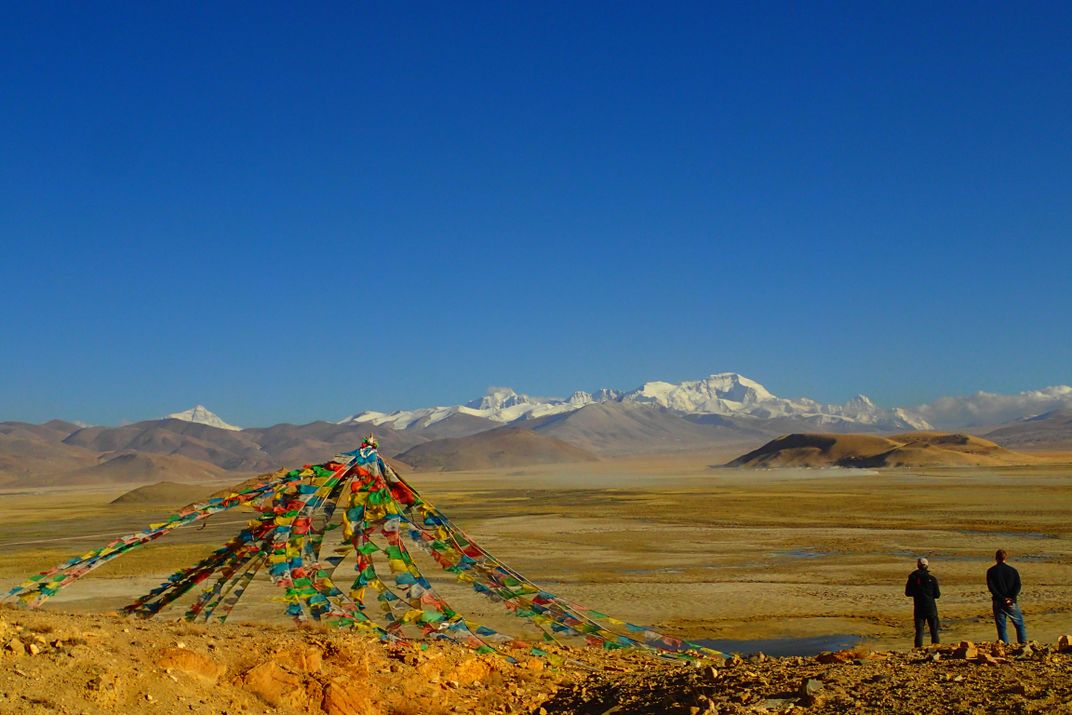Footprints Found at Ancient Hot Springs Could Represent Earliest Settlement of Tibetan Plateau
New age measurements of the footprints help pinpoint when humans first settled the highest region on Earth
/https://tf-cmsv2-smithsonianmag-media.s3.amazonaws.com/filer/cf/76/cf76491e-d6ed-43c0-9342-3662afef320c/plateau_handprints.jpg)
Thousands of years ago, a group of six humans meandered along the edge of a bubbling hot spring on the Tibetan Plateau, the tallest plateau on Earth. The humans scampered around, leaving foot and handprints behind in soft clay that later hardened into cement-like rock. Today, these provocative prints offer rare clues as to when humans first settled what is known as the “roof of the world.”
The prints—located more than 14,000 feet above sea level in the central region of the plateau at a site called Chusang—were discovered nearly 20 years ago and consist of six pairs, including two smaller ones that may be from children. Now, researchers have used high precision dating techniques to determine the most reliable age yet of these long-studied prints, placing them between 7,400 to 12,670 years old.
The researchers also suggest that these could represent the earliest known permanent settlement on the Tibetan Plateau, which towers thousands of feet high in central Asia. Such a feat that would have required significant physiological evolution to withstand the low oxygen levels at high elevations, the team reports today in the journal Science.
“To live on the plateau successfully and permanently, you really do need these genetic adaptations that provide you with the means to do so,” says study co-author Mark Aldenderfer, an archaeologist at the University of California at Merced.
For instance, humans living at such altitudes would need to use oxygen more efficiently than those at lower elevations, says Aldenderfer. Modern Tibetans have just these kind of genetic adaptations: Studies have shown that they have double the forearm blood flow than lower altitude residents, an indicator of greater overall blood-flow through the body.
The team believes that the site most likely represents permanent settlers, because it is located too far from the closest possible base camp to have warranted seasonal travel (especially if there were children in tow). While nobody has unearthed any structures that look like permanent homes in the area yet, Aldenderfer suggests that the humans could have lived in pit houses and subsisted on food like wild yak, antelope and various wild grasses.
What drew people to this particular hot spring site—which has since dried up—remains uncertain. But it’s not difficult to imagine the appeal of the warmth on the otherwise frigid plateau, Aldenderfer says. The prints, which appear to have been made deliberately, may represent ancient play, Aldenderfer muses. “I think it must have been the sheer novelty of it all: a warm, pliable, and sticky substance that you could leave a mark in,” says Aldenderfer.

To get a precise age for the prints, the team gathered a combination of cement-like rock material from the prints and plant remains from the surrounding area. Then, they triangulated the age by using three existing dating techniques. The new dates offer a more precise window than the previous estimate—which ranged from 5,200 to 20,000 years ago—and also line up well with data on when modern Tibetans evolved genes that help them thrive in low oxygen conditions, the team reports.
“The fact that this is re-dated is pretty remarkable because it rules out really early forays into the Tibetan Plateau, and is consistent with other efforts in areas around the plateau,” says Loukas Barton, an archaeologist at the University of Pittsburgh who studies the cultural implications of human adaptation to high-elevation Tibet.
Still, Barton does not think there is enough evidence to conclude that the footprints represent a permanent settlement, as opposed to a group of seasonally traveling hunter-gatherers.
Barton says that people typically move to highlands due to interpersonal conflict or competition for food at lower elevations. “If that were true around the Tibetan Plateau 8,000 years ago, that would be fascinating because we have no evidence for that,” says Barton, who was not involved in this new study.
Martin Jones, an archaeologist at the University of Cambridge who has studied the timing of the first permanent Tibetan Plateau settlements, agrees that the time constraints provided by this new study are helpful, but agrees with Barton that not enough evidence exists to know for sure whether the print-makers were permanent residents.
“Arguing for permanent occupation when you haven’t found a settlement is tough,” says Jones, who was also not involved in the study.
Jones has published research suggesting that the development of agropastorilism—an economy based on agriculture and livestock—facilitated the onset of year-round settlements in these harsh environments, and didn’t occur until around 3,600 years ago. But Aldenderfer’s team argues that humans could theoretically have subsisted on the plateau before this cultural development had fully taken hold.
Despite these unknowns, Jones says this work provides a valuable glimpse into what it means to be human. Most great apes stayed in Africa where they originated from, for example, but humans have journeyed all around the world to some of the most inhospitable places, Jones says.
“I think an intrinsic thing of human ecology is that we go on long journeys,” Jones says, adding that language is also central to taking long journeys, as it allows us to relay itineraries.
So even if we’ll never know for sure whether those footprints were made by farmers, or youngsters doing cartwheels around a hot spring, they do demonstrate something fundamental about human nature, Jones says. “There are journeys like that in our species all over the place,” says Jones. “I would say we are a journeying, storytelling species and we do end up in odd places.”